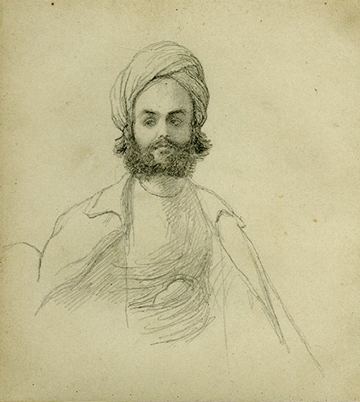Name Azimullah Khan | Died 1858 | |
 | ||
Azimullah Khan Yusufzai (1830-1859), also known as Dewan Azimullah Khan, was initially appointed Secretary, and later Prime Minister (hence the prefix Dewan) to Nana Sahib. He is also known as the Krantidoot Azimullah Khan (Krantidoot in Hindi for "Ambassador of Revolution").
Contents
- Origins
- The Maratha mission
- England
- Constantinople
- Subversion and revolt
- In Popular culture
- Additional readings
- References
Azimullah Khan was involved in the Indian Rebellion of 1857, primarily ideologically, influencing important nobles such as Nana Sahib.
Origins
Azimullah was rescued as a starving Muslim boy from the famine of 1837-38 along with his mother when they were provided shelter at a mission in Cawnpore. There he learnt English but also French, no mean achievement for an Indian in the 19th century.
After working as secretary to several British officers, he was taken into the service of the Nana Sahib, adopted son of the late Peshwa Baji Rao II (died 28 January 1851), as secretary and advisor.
The Maratha mission
Nana Sahib was involved in a long drawn out appeal to the British East India Company to restore to him the £80,000 annual pension that his father (exiled to the Kingdom of Oudh) had been granted. He chose the smooth-talking Azimullah to go to England in 1853 to plead his case with the Board of Control, the British government, or anyone else who cared to listen.
England
In England, Azimullah was taken under the wing of Lucie, Lady Duff-Gordon, an intellectual and translator whose husband was a civil servant, court functionary and the cousin of the then Prime Minister. This introduction probably came about through the philosopher John Stuart Mill, who was an official of the East India Company and had been a childhood friend of Lucie's. Azimullah lodged with the Duff Gordons at their home in Esher, and in Lucie's company may have met her friends Dickens, Carlyle, Meredith, Tennyson, Browning and Thackeray (though there is no direct evidence).
Lucie's attitude to Azimullah was probably motherly, but other, younger, British ladies seem to have entered into compromising relationships with him. His charm, good looks, and gorgeous costumes - and perhaps also the assumption (which he may even have encouraged) that he was a genuine Indian prince - made him an attractive, exotic figure. Despite his social success, and the outlay of £50,000 of his master's money, the mission to London was unsuccessful which made Azimullah bitter and frustrated.
Constantinople
On his way back, Azimullah's retinue stopped in Constantinople, which was then part of the Ottoman Empire. He also visited the battlefield of Crimea and saw tired British soldiers returning, and heard reports of bad leadership from British officers (see Charge of the Light Brigade). Azimullah is reported to have contacted Turkish and Russian spies.
Subversion and revolt
Although his mission had failed, he probably came back with a more dangerous idea, planting in the Nana Sahib's mind the seed of the Indian rebellion of 1857. (Azimullah also brought back a French printing press, which was used - by others - to print and distribute subversive literature against the British in India.)
Azimullah's own role in the great uprising that followed, the "Indian Mutiny", was political rather than military. Although he was chief advisor to the Nana Sahib, one of the principal leaders of the rebellion, he was a Muslim at a Hindu court, a talker, at a time when military men were needed, and without personal wealth, nobility, or a following of supporters, and so he soon became a marginal figure. He was, according to some accounts, complicit in the two notorious massacres at Cawnpore - the treacherous attack on the retreating British at the Satichaura Ghat, and the slaying of the women and children held captive in the Bibighar, or House of the Women.
Azimullah Khan probably died of a fever in late 1859, after the crushing of the rebellion, on the run from the British in the inhospitable border country of the Nepalese Terai.
In Popular culture
Azimullah Khan was portrayed by actor Shahbaz Khan in the 2005 movie Mangal Pandey: The Rising.
